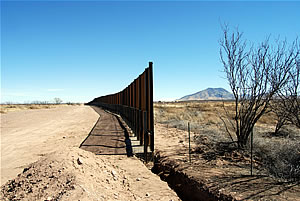Immigration Laws

The Secure Fence Act of 2006 mandated
the construction of this barrier between
the U.S. and Mexico. (Shutterstock.com)
U.S. Constitution (1789) gave Congress the power to "establish an uniform Rule of Naturalization."
Immigration Act of 1819 set standards for vessels bringing immigrants. Ship captains had to provide customs officials with a list of immigrants describing where they came from, where they were going, and their age, sex, and occupation. Passengers ill with contagious diseases had to be quarantined. States carried out the provisions of this law.
Treaty of Guadalupe Hidalgo (1848) granted U.S. citizenship to Mexicans living in the territory ceded by Mexico to the United States.
14th Amendment to the U.S. Constitution (1868) guaranteed that "All persons born or naturalized in the United States . . . are citizens of the United States . . . ."
Chinese Exclusion Act (1882) banned for 10 years Chinese immigration and eligibility for citizenship. The law was renewed in 1892 and made permanent in 1902. It was not repealed until World War II.
Contract Labor Law of 1885 outlawed the practice of signing up foreign laborers to work in America for low wages. No immigrant could have a job or a promise of a job before landing.
Immigration Act of 1891 gave the job of processing immigrants to the federal government. Federal inspectors examined immigrants on arrival. The law also barred persons suffering from "loathsome or dangerous diseases," those convicted of crimes involving "moral turpitude," polygamists, and those whose passage was paid for by others. Those rejected for immigration were deported at the expense of the shipping companies.
Immigration Act of 1907 allowed the president to make an agreement with Japan to limit the number of Japanese immigrants. The law also barred the feebleminded, those with physical or mental defects, those suffering from tuberculosis, children under 16 without parents, and women entering for "immoral purposes."
Immigration Act of 1917 banned all "aliens over sixteen years of age, physically capable of reading, who cannot read the English language, or some other language or dialect . . . ."
National Origins (First Quota) Act of 1921 limited the number of immigrants from any country to 3 percent of the foreign-born persons of that nationality living in the United States in 1910. This formula provided for relatively large immigrant quotas for Northern Europe and small quotas for Southern and Eastern Europe.
National Origins (Second Quota) Act of 1924 further discriminated against Southern and Eastern Europeans by limiting the number of immigrants from any country to 2 percent of foreign born persons of that nationality living in the U.S. in 1890. Only 164,000 immigrants were to be admitted each year; this total was further reduced to 150,000 in 1929. The law also imposed new restrictions on Asian immigration.
Displaced Persons Act of 1948 allowed into the United States refugees from countries ravaged by World War II, but their entry was charged to the national quota limits established in 1924.
McCarran-Walter Act of 1952 maintained the quota system and limited immigration to 150,000 persons a year. In addition, refugees fleeing communist countries were admitted under special parole authority of the U.S. attorney general.
Immigration Act of 1965 abolished the national origins quota system. Preference is given to skilled persons and immigrants who are closely related to American citizens. After five years residency in the United States, immigrants may apply for naturalized citizenship.
Refugee Act of 1980 defined a "refugee" as any person leaving his or her own country because of a "well founded fear of persecution on account of race, religion, nationality, membership in a particular group, or political opinion."
Immigration Reform and Control Act of 1986 made it illegal for employers to knowingly hire unauthorized immigrants. It also set up a process to grant amnesty and legal papers to about 1.5 million undocumented people in the United States.
Illegal Immigration Reform and Immigrant Responsibility Act of 1996 authorized more Border Patrol agents and a triple fence along the San Diego border, made tougher penalties for smuggling people and creating fraudulent documents, and created an "expedited removal" process to remove anyone trying to enter the United States without proper documents.
USA Patriot Act of 2001 put immigration under the control of the newly created Department of Homeland Security and tripled the budget for Border Patrol agents along the Canadian border.
The Secure Fence Act of 2006 authorized the construction of hundreds of miles of fencing, lighting, and surveillance technology along the U.S.-Mexico border to curb unauthorized immigration.


